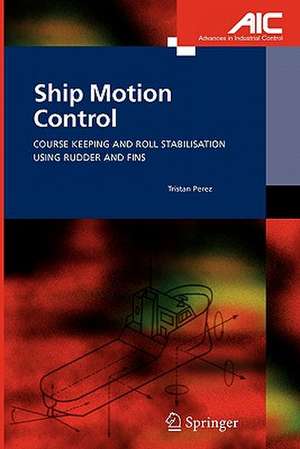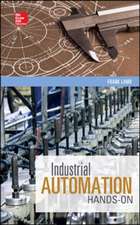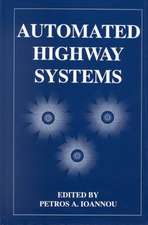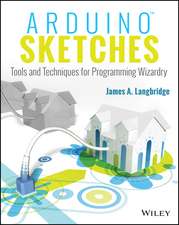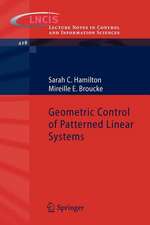Ship Motion Control: Course Keeping and Roll Stabilisation Using Rudder and Fins: Advances in Industrial Control
Autor Tristan Perezen Limba Engleză Paperback – 21 oct 2010
| Toate formatele și edițiile | Preț | Express |
|---|---|---|
| Paperback (1) | 1381.43 lei 6-8 săpt. | |
| SPRINGER LONDON – 21 oct 2010 | 1381.43 lei 6-8 săpt. | |
| Hardback (1) | 1387.55 lei 6-8 săpt. | |
| SPRINGER LONDON – 8 iun 2005 | 1387.55 lei 6-8 săpt. |
Din seria Advances in Industrial Control
- 15%
 Preț: 643.34 lei
Preț: 643.34 lei - 23%
 Preț: 582.63 lei
Preț: 582.63 lei - 18%
 Preț: 783.98 lei
Preț: 783.98 lei - 18%
 Preț: 947.35 lei
Preț: 947.35 lei - 20%
 Preț: 568.24 lei
Preț: 568.24 lei - 15%
 Preț: 643.16 lei
Preț: 643.16 lei - 18%
 Preț: 899.21 lei
Preț: 899.21 lei - 18%
 Preț: 891.33 lei
Preț: 891.33 lei - 18%
 Preț: 740.57 lei
Preț: 740.57 lei - 18%
 Preț: 961.23 lei
Preț: 961.23 lei - 18%
 Preț: 955.08 lei
Preț: 955.08 lei - 15%
 Preț: 645.28 lei
Preț: 645.28 lei - 15%
 Preț: 638.43 lei
Preț: 638.43 lei - 18%
 Preț: 901.11 lei
Preț: 901.11 lei - 18%
 Preț: 1410.94 lei
Preț: 1410.94 lei - 18%
 Preț: 728.91 lei
Preț: 728.91 lei - 20%
 Preț: 1003.77 lei
Preț: 1003.77 lei - 18%
 Preț: 947.35 lei
Preț: 947.35 lei - 15%
 Preț: 643.34 lei
Preț: 643.34 lei - 15%
 Preț: 654.30 lei
Preț: 654.30 lei - 18%
 Preț: 950.52 lei
Preț: 950.52 lei - 15%
 Preț: 644.30 lei
Preț: 644.30 lei - 18%
 Preț: 1393.09 lei
Preț: 1393.09 lei - 18%
 Preț: 950.21 lei
Preț: 950.21 lei - 18%
 Preț: 949.90 lei
Preț: 949.90 lei - 18%
 Preț: 949.42 lei
Preț: 949.42 lei - 18%
 Preț: 950.52 lei
Preț: 950.52 lei - 18%
 Preț: 1113.71 lei
Preț: 1113.71 lei - 15%
 Preț: 650.04 lei
Preț: 650.04 lei - 15%
 Preț: 644.95 lei
Preț: 644.95 lei - 18%
 Preț: 950.33 lei
Preț: 950.33 lei - 18%
 Preț: 948.61 lei
Preț: 948.61 lei - 18%
 Preț: 1112.60 lei
Preț: 1112.60 lei - 15%
 Preț: 644.63 lei
Preț: 644.63 lei - 18%
 Preț: 953.20 lei
Preț: 953.20 lei - 18%
 Preț: 945.62 lei
Preț: 945.62 lei - 15%
 Preț: 640.88 lei
Preț: 640.88 lei - 15%
 Preț: 640.88 lei
Preț: 640.88 lei - 20%
 Preț: 650.92 lei
Preț: 650.92 lei - 18%
 Preț: 1112.60 lei
Preț: 1112.60 lei - 20%
 Preț: 998.36 lei
Preț: 998.36 lei - 15%
 Preț: 643.34 lei
Preț: 643.34 lei - 18%
 Preț: 948.92 lei
Preț: 948.92 lei - 15%
 Preț: 651.51 lei
Preț: 651.51 lei - 15%
 Preț: 647.08 lei
Preț: 647.08 lei - 20%
 Preț: 563.66 lei
Preț: 563.66 lei - 18%
 Preț: 992.64 lei
Preț: 992.64 lei - 18%
 Preț: 1225.79 lei
Preț: 1225.79 lei
Preț: 1381.43 lei
Preț vechi: 1684.67 lei
-18% Nou
Puncte Express: 2072
Preț estimativ în valută:
264.33€ • 275.98$ • 218.77£
264.33€ • 275.98$ • 218.77£
Carte tipărită la comandă
Livrare economică 04-18 aprilie
Preluare comenzi: 021 569.72.76
Specificații
ISBN-13: 9781849969789
ISBN-10: 1849969787
Pagini: 324
Ilustrații: XXI, 300 p.
Dimensiuni: 155 x 235 x 17 mm
Greutate: 0.45 kg
Ediția:Softcover reprint of hardcover 1st ed. 2005
Editura: SPRINGER LONDON
Colecția Springer
Seria Advances in Industrial Control
Locul publicării:London, United Kingdom
ISBN-10: 1849969787
Pagini: 324
Ilustrații: XXI, 300 p.
Dimensiuni: 155 x 235 x 17 mm
Greutate: 0.45 kg
Ediția:Softcover reprint of hardcover 1st ed. 2005
Editura: SPRINGER LONDON
Colecția Springer
Seria Advances in Industrial Control
Locul publicării:London, United Kingdom
Public țintă
ResearchCuprins
Ship Modelling for Control.- Environmental Disturbances.- Kinematics of Ship Motion.- Ship Kinetics.- Control Surfaces (Actuators).- to Ship Motion Control.- to Ship Roll Stabilisation.- Ship Roll Stabilisation.- Ship Motion Performance.- Performance Limitations in Feedback Control with Application to Ship Roll Stabilisers.- Linear Performance Limitations.- Constrained Performance Limitations.- Control System Design for Autopilot with Rudder Roll Stabilisation and Fin Stabilisers.- Previous Research in Control of Rudder Roll Stabilisation and Fin Stabilisers.- Constrained Control via Optimisation.- Control System Design for Autopilots with Rudder Roll Stabilisation.- Constrained Control of Fin Stabilisers.
Notă biografică
Tristan Perez has a strong interest in the area of dynamic modelling nad control which has been focussed towards marine applications since his Ph.D. This book is the culmination of five years of research effort which has already given rise to the publication of refereed journal papers and professional magazine articles. He has also had industrial experience, working in a shipyard on the area of seakeeping (ship performance). The book is written with knowledge of the user’s point of view because of this experience.
Doctor Perez transferred from the well-known and respected control group at The University of Newcastle, Australia to the Centre for Ships and Ocean Structures at the Norwegian University of Science and Technology in June 2004.
Doctor Perez transferred from the well-known and respected control group at The University of Newcastle, Australia to the Centre for Ships and Ocean Structures at the Norwegian University of Science and Technology in June 2004.
Textul de pe ultima copertă
The impact of control system design on ship performance has been significant in different applications of ship motion control: course keeping, station keeping, roll stabilisation and vertical motion/riding control, diving, path following, etc. This monograph introduces ship motion control by studying the particular problems of control system design for course autopilots with rudder roll stabilisation and combined rudder–fin stabilisers. Ship Motion Control revisits the ingredients that make these control designs challenging and proposes a contemporary control system design approach to meet that challenge.
The key ingredients for a successful ship motion control system design are:
• appropriate mathematical models of the ship and the disturbances;
• understanding of how performance will be assessed;
• knowledge of fundamental limitations that may prevent designs from achieving the desired performance.
The book is organised in four parts, the first three dealing with each of these and the fourth part addressing control system design.
Specific topics covered include:
• modelling and simulation of ocean waves;
• ship dynamics;
• models of actuators;
• ship roll stabilisation devices;
• ship motion performance;
• analysis of fundamental limitations for stabiliser control system design;
• constrained control design via optimisation;
• autopilot design using optimal control;
• wave filtering;
• control system design for autopilots with rudder roll stabilisation;
• control system design for integrated rudder-fin stabiliser.
Ship Motion Control will be of interest not only to the practising marine engineer but to the academic engaged in researchinto this important control problem, even if new to the area. It will also be an ideal source of reference for students and tutors involved with marine and control engineering courses.
Advances in Industrial Control aims to report and encourage the transfer of technology in control engineering. The rapid development of control technology has an impact on all areas of the control discipline. The series offers an opportunity for researchers to present an extended exposition of new work in all aspects of industrial control.
The key ingredients for a successful ship motion control system design are:
• appropriate mathematical models of the ship and the disturbances;
• understanding of how performance will be assessed;
• knowledge of fundamental limitations that may prevent designs from achieving the desired performance.
The book is organised in four parts, the first three dealing with each of these and the fourth part addressing control system design.
Specific topics covered include:
• modelling and simulation of ocean waves;
• ship dynamics;
• models of actuators;
• ship roll stabilisation devices;
• ship motion performance;
• analysis of fundamental limitations for stabiliser control system design;
• constrained control design via optimisation;
• autopilot design using optimal control;
• wave filtering;
• control system design for autopilots with rudder roll stabilisation;
• control system design for integrated rudder-fin stabiliser.
Ship Motion Control will be of interest not only to the practising marine engineer but to the academic engaged in researchinto this important control problem, even if new to the area. It will also be an ideal source of reference for students and tutors involved with marine and control engineering courses.
Advances in Industrial Control aims to report and encourage the transfer of technology in control engineering. The rapid development of control technology has an impact on all areas of the control discipline. The series offers an opportunity for researchers to present an extended exposition of new work in all aspects of industrial control.
Caracteristici
Shows the reader the results of applying modern control methods to a problem that has been open in research for twenty years Presents the reader with a good idea of what is realistically achievable in the control of ship stabilization and where design effort can be applied most productively Includes supplementary material: sn.pub/extras
